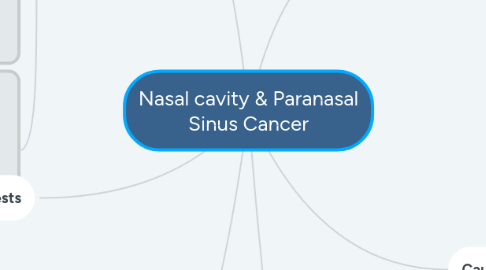Nasal cavity & Paranasal Sinus Cancer
por Kyle Kelly

1. Risk Factors
1.1. Tobacco smoking
1.2. Working environments
1.2.1. Carpentry/wood dust
1.2.2. Working with formaldehyde
1.2.3. Textile manufacturing
1.2.4. “Occupational exposure to wood dusts have a 500- to 900-fold increased risk of developing sinonasal adenocarcinoma compared with the general population (Dagan, 2017).
1.3. HPV
1.3.1. 32% of cases
2. Diagnostic Tests
2.1. History and physical exam
2.2. Tumor staging
2.2.1. American Joint Committee on Cancer’s staging system
2.3. Biopsy of tumors
2.4. Imaging
2.4.1. CT, MRI, and PET-CT
3. Treatment
3.1. Surgery
3.2. Radiation Therapy (RT)
3.2.1. Can be used to shrink tumor prior to surgery.
3.3. Chemotherapy
3.3.1. When surgery and RT are contraindicated
3.4. Proton or carbon ion therapy may improve outcomes (Bossi et al., 2016)
4. References
4.1. Dagan, R., Amdur, R. J., & Dziegielewski, P. T. (2017). Tumors of the nasal cavity. UpToDate. Retrieved March 28, 2018, from https://www.uptodate.com/contents/tumors-of-the-nasal-cavity?search=nasal cavity cancer&source=search_result&selectedTitle=1~22&usage_type=default&display_rank=1.
4.2. McCance, K. L., & Huether, S. E. (2014). Pathophysiology: the biologic basis for disease in adults and children (7th ed.). St. Louis,, MO: Elsevier.
4.3. Bossi, P., Farina, D., Gatta, G., Lombardi, D., Nicolai, P., & Orlandi, E. (2016). Paranasal sinus cancer. Critical Reviews in Oncology/Hematology, 98, 45-61. doi:10.1016/j.critrevonc.2015.09.009
5. Pathophysiologic etiology
5.1. Squamous cell carcinoma is the most common.
5.2. Most patients are diagnosed after age 60 with no racial distribution
5.3. Account for less than 0.5% of all cancers (Dagan, Amdur, & Dziegielewski, 2017)
5.4. Inflammation and Injury
6. Causative factors
6.1. Isopropyl alcohol production.
6.2. Leather dust
6.3. Nickel compounds
6.4. Radium-226 and its decay products Radium-228 and its decay products
6.5. Tobacco smoking
6.6. Wood dust
6.7. Reoccurring infections
6.8. (McCance, 2014, p. 407)
7. Post-Treatment
7.1. Since 80-90% of recurrences occur during the first 2 year, follow-ups are necessary every three months during this time
7.2. CT or MRI every 3-4 months for 2 years



